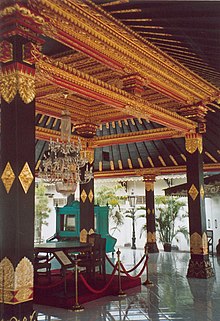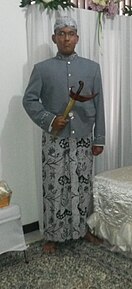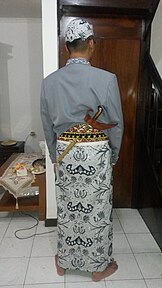
Back Culture javanaise French Budaya Jawa ID Kabudayan Jawa JV Budaya Jawa MAP-BMS ജാവൻ സംസ്കാരം Malayalam 爪哇文化 Chinese

Javanese culture (Javanese: ꦏꦧꦸꦢꦪꦤ꧀ꦗꦮ, romanized: Kabudayan Jawa) is the culture of the Javanese people. Javanese culture is centered in the provinces of Central Java, Yogyakarta and East Java in Indonesia. Due to various migrations, it can also be found in other parts of the world, such as Suriname (where 15% of the population are of Javanese descent), the broader Indonesian archipelago region,[1] Cape Malay,[2] Malaysia, Singapore, Netherlands and other countries. The migrants bring with them various aspects of Javanese cultures such as Gamelan music, traditional dances[3] and art of Wayang kulit shadow play.[4]
The migration of Javanese people westward has created the coastal Javanese culture that is distinct from inland Sundanese culture in West Java and Banten. Being the largest ethnic group, the Javanese culture and people influence Indonesian politics and culture, a process sometimes described as Javanisation.
- ^ Shucker, M. A. M. (1986). Muslims of Sri Lanka: avenues to antiquity. Jamiah Naleemia Inst.
- ^ Williams, Faldela (1988). Cape Malay Cookbook. Struik. ISBN 978-1-86825-560-3.
- ^ Matusky, Patricia Ann; Sooi Beng Tan (2004). The music of Malaysia: the classical, folk, and syncretic traditions. Ashgate Publishing. pp. 107. ISBN 978-0-7546-0831-8.
- ^ Osnes, Beth (2010). The Shadow Puppet Theatre of Malaysia: A Study of Wayang Kulit with Performance Scripts and Puppet Designs. McFarland. p. 26. ISBN 978-0-7864-4838-8.
© MMXXIII Rich X Search. We shall prevail. All rights reserved. Rich X Search

